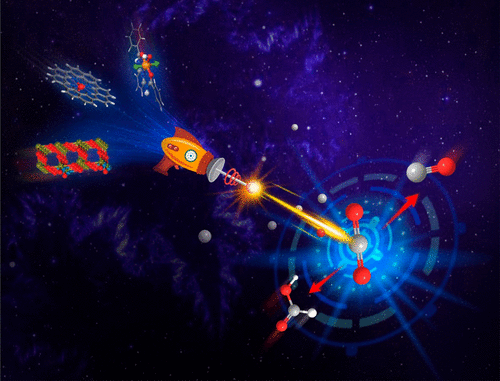Recently, a research group led by Prof. HUANG Yanqiang and Prof. ZHANG Tao from the Dalian Institute of Chemical Physics (DICP) of the Chinese Academy of Sciences reported an advanced review paper entitled "Single-Atom Catalysis toward Efficient CO2Conversion to CO and Formate Products" in Account of Chemical Research. It briefly summarized the newly research on the development of single-atom catalysts for efficient catalytic conversion of CO2 and it was selected as the supplementary cover article.

Single-atom catalysts offer great opportunity for efficient conversions of CO2 with well-defined sites from metal individuals and the collaboration with substrate microenvironments. (Image by SU Xiong)
The concept of “Single-Atom Catalysis” was jointly proposed by Prof. ZHANG Tao from DICP, Prof. LI Jun from Tsinghua University, and Prof. LIU Jingyue from Arizona State University in 2011. In recent years, lots of research groups have made outstanding progress in the fields of electrocatalysis, photocatalysis and traditional heterogeneous catalysis based on single-atom catalysis. The review focuses on the efficient catalytic conversion of CO2 by single-atom catalysts.
Prof. HUANG Yanqiang and colleagues have long been committed to the research of thermo- and electric- catalytic conversion of CO2. By means of the utilization of lattice-matching strategy between metal and support, the functionalization of carrier with additive groups and the regulation of the electronic state of active centers and so on, the product selectivities for CO2 transformation were controllable. The particularity of the specific structure of single-atom catalyst provided an ideal model for the activation and directional transformation of CO2.
By utilizing the characteristics of lattice matching of the same crystal type between IrO2 and rutile TiO2, a highly thermal-stable Ir1/TiO2 catalyst was prepared, which was demonstrated to be efficient in selective transformation of CO2 to CO (ACS Catalysis).
In collaboration with Prof. LIU Bin' team from Nanyang Technological University, a nitrogen-doped graphene anchored Ni single-atom catalyst was developed. With the facility of the unpaired 3d electrons in the outermost layer of Ni single atom easily to be delocalized and the formation of electronegative Ni-CO2δ- species, a highly efficient electrochemical reduction process of CO2 to CO was realized (Nature Energy).
By simulating the efficient transforming mechanism of CO2 over homogeneous catalyst at low temperature, a single-atom Ir catalyst supported by a porous organic polymer carrier containing pyridine-amide groups was fabricated. On this basis, the quasi-homogeneous activation and catalytic conversion of CO2 were successfully achieved (Nature Communications; Chem).
These results provided new ideas for the design of high efficiency CO2 reduction catalysts.
This work was supported by the National Key R&D Program of China, the Strategic Priority Research Program of the CAS, and etc. This is also one of the articles dedicated for the 70th anniversary of DICP. (Text by SU Xiong)